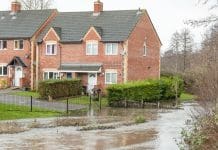At least one in six properties is at risk of flooding in England according to the Environment Agency
Government has always been perceived as the first body responsible for flood protection. However, absolute protection from floods cannot be guaranteed due to ever-changing environmental conditions and unpredictable natural events.
Luckily, the impact of flood on properties can be minimised and this is where property flood resilience comes to play.
What is property flood resilience?
Property Flood Resilience (PFR), also known as Property Level Protection (PLP), is about having measures at properties to minimise the impact of flooding and lower flood risk.
The SMARTeST project, an EU FP7-funded research project aimed to improve flood resilience technology, described six steps to make property more resilient to flooding, which are: understanding the risk; planning; survey; product supply; installation; and maintenance.
There are various products and services on the market developed to provide affordable and effective flood resilient measures to prevent and reduce flood damage.
…And why is it important?
Flood damage to properties, valuables and losing sentimental items can be devastating both emotionally and financially.
There is flood insurance to help cover recovery cost after an event of flood, for example Flood Re. A lot of homeowners are relying on insurance to cover flood damage but are not fully aware of the PFR measures they can put in place.
It is good to have financial support for flood insurance. However, it would make sense to protect your home from flood damage in the first place.
Having flood resilience measures in place can limit and prevent flood damage, subsequently reduce the recovery time and cost of repair. It also offers a peace of mind when unexpected flood occurs while people are away from home.
So, who is responsible?
The government has been involved in various areas of flood protection, such as funding flood defences projects, recovery support, promote innovation within the flood resilience market. However, government does not have the authority to act on private properties without the consent of owners.
The majority of property owners are relying on the government to provide flood protection. Nonetheless, recent research suggests homeowner implementing property level measures could help further reduce flood risk by 50% and subsequently reduce the need for public risk management in the long run.
BSI Group has updated the standards on flood resilience products and BRE Group is releasing a code of practice and guidance on PFR in late 2020. These can help regulate the quality of flood resilience products available on the market, ensuring the product or services acquired by homeowners can effectively protect them from events of flood.
In conclusion, it is a collaborative role on reducing flood risk: government has the responsibility to provide public flood protection and raise awareness, and homeowners should also accept the responsibility to realise the risks and safeguard their homes.

What role does StormMeister® have in flood resilience?
Innovation is at the heart of StormMeister. Thus, StormMeister is working with University of Central Lancashire and the Flood Innovation Centre from the University of Hull to drive research and development to bring innovation to the PFR market.
Investment in flood resilience products can be justified when compared to recovery costs without any PFR measures. When you are buying a flood door or any flood protection product, it is important to know that they have been fully type-tested and are able to perform the job they are purported to do.
StormMeister has over 10 years of experience in providing quality flood resilience service and products for both residential and commercial properties. For more information, please follow the link: www.StormMeister.com.
Some of the services and products we provide:
- Flood barriers.
- Flood doors (Standard, Low threshold,
- Bi-Fold).
- Flood gates (residential and industrial use).
- Flood windows.
- Maintenance and inspection.
Our flood doors are easy-to-use, suitable for everyone including elderly, infirm and disabled. All StormMeister products are tested to the PAS 1188-1:2014 standards.
StormMeister is a BSI member company and has worked with BSI on drafting the new British Standards for flood resilience products, BS 851188-1:2019, in particular regards to handle force required to lock flood doors. The maximum handle force is now set at 10Nm, which is well within the design limits of most flood door locking mechanisms.
Interesting reads:
The SMARTeST project. Six Steps to Property Level Flood Resilience: Guidance for property owners.
Thomas Hartmann, Robert Jüpner. Implementing resilience in flood risk management. WIREs Water.
Code of Practice and guidance for property flood resilience – RP1055
Claudia Mak
Head of Design
William M Snape Manufacturing Services (UK) Ltd.
Trading as StormMeister Flood Protection
Tel: +44 (0)1772 704429
Twitter: Stormmeister
LinkedIn: Stormmeister Flood Protection
Facebook: Stormmeister
YouTube: Stormmeister
Please note: this is a commercial profile.








![[VIDEO] Making DorTrak reports easy to read with Fireco Inspecting fire doors at Fireco, firedoor technology, 2023](https://www.pbctoday.co.uk/news/wp-content/uploads/2024/04/JPZ_2364-web-218x150.jpg)
![[VIDEO] Re-flow Field Management review by Traffic Management Installations When TMI began subcontracting for councils and government bodies, they wanted to present their site reporting in a more professional manner](https://www.pbctoday.co.uk/news/wp-content/uploads/2025/03/TMI-Media-1-218x150.png)




